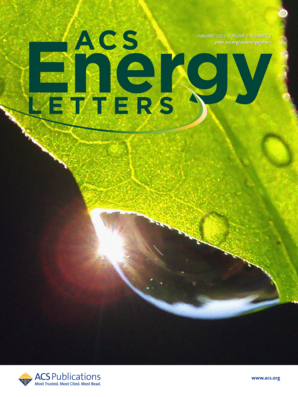合金阳极与固态电解质的化学机械配对
IF 19.3
1区 材料科学
Q1 CHEMISTRY, PHYSICAL
引用次数: 0
摘要
合金阳极是固态电池中碱金属的理想替代品,但在循环过程中仍面临形态不稳定的问题。与使用液态电解质的传统电池不同,固态电解质与合金阳极之间的界面演变是由界面电化学和力学决定的。在此,我们将锂金属的经典化学机械模型应用于合金阳极。这样就可以推广一种原理,即软硬电解质与合金阳极配对原理,为提高形态稳定性提供指导。具体来说,"硬"(高剪切模量)陶瓷电解质应与 "硬 "合金配对,而 "软"(低剪切模量)聚合物电解质应与 "软 "合金配对。我们研究了几种锂-M 合金(M = Al、Mg、In、Sn 和 Sb)的化学机械特性。与原理相符,"较硬 "的锂-锰阳极在循环后与 "较硬 "的 Li6PS5Cl 电解质一起呈现出扁平的形态。相反,"较软 "的锂-铟阳极则变得非常粗糙,表明锂-铟枝晶的形成。我们的工作强调了结合传统冶金学的既定规则调整合金阳极机械性能的重要性。本文章由计算机程序翻译,如有差异,请以英文原文为准。

Chemomechanical Pairing of Alloy Anodes and Solid-State Electrolytes
Alloy anodes present promising alternatives to alkali metals in solid-state batteries but still face morphological instability upon cycling. Unlike conventional batteries using liquid electrolytes, interfacial evolution between solid-state electrolytes and alloy anodes is determined by interfacial electrochemistry and mechanics. Here, we adapt a classical chemomechanical model for Li metal to apply to alloy anodes. This allows generalizing a principle, namely, the hard and soft electrolytes and alloy anodes pairing principle, to guide improving morphological stability. Specifically, “hard” (high-shear-modulus) ceramic electrolytes should be paired with “harder” alloys, while “soft” (low-shear-modulus) polymer electrolytes favor “softer” alloys. We examine the chemomechanical properties of several Li–M alloys (M = Al, Mg, In, Sn, and Sb). Consistent with the principle, the “harder” Li–Sn anode exhibits a flattened morphology with the “hard” Li6PS5Cl electrolyte after cycling. Conversely, the “softer” Li–In anode evolves extremely rough, indicating Li–In dendrite formation. Our work underscores the significance of tuning alloy anode mechanical properties, incorporating well-established rules in traditional metallurgy.
求助全文
通过发布文献求助,成功后即可免费获取论文全文。
去求助
来源期刊

ACS Energy Letters
Energy-Renewable Energy, Sustainability and the Environment
CiteScore
31.20
自引率
5.00%
发文量
469
审稿时长
1 months
期刊介绍:
ACS Energy Letters is a monthly journal that publishes papers reporting new scientific advances in energy research. The journal focuses on topics that are of interest to scientists working in the fundamental and applied sciences. Rapid publication is a central criterion for acceptance, and the journal is known for its quick publication times, with an average of 4-6 weeks from submission to web publication in As Soon As Publishable format.
ACS Energy Letters is ranked as the number one journal in the Web of Science Electrochemistry category. It also ranks within the top 10 journals for Physical Chemistry, Energy & Fuels, and Nanoscience & Nanotechnology.
The journal offers several types of articles, including Letters, Energy Express, Perspectives, Reviews, Editorials, Viewpoints and Energy Focus. Additionally, authors have the option to submit videos that summarize or support the information presented in a Perspective or Review article, which can be highlighted on the journal's website. ACS Energy Letters is abstracted and indexed in Chemical Abstracts Service/SciFinder, EBSCO-summon, PubMed, Web of Science, Scopus and Portico.
 求助内容:
求助内容: 应助结果提醒方式:
应助结果提醒方式:


